Resident Crews of the International Space Station (ISS)
![]()
ISS: Expedition 60 |
 |
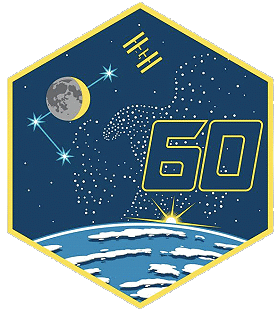 |
 |
crew poster |
|
 |
 |
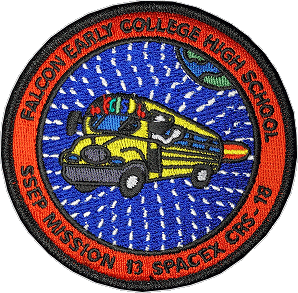 |
 |
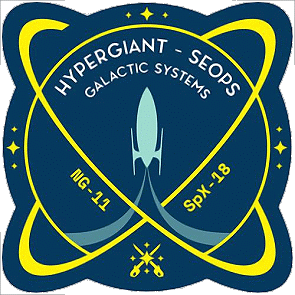 |
 |
 |
|
![]()
Crew, launch- and landing data
| No. | Nation | Surname | Given names | Position | Spacecraft (launch) |
Launch date |
Launch time |
Spacecraft (landing) |
Landing date |
Landing time |
Mission duration |
Orbits |
| 1 | Ovchinin | Aleksei Nikolaevich | ISS-CDR | Soyuz MS-12 | 14.03.2019 | 19:14:08.175 UTC | Soyuz MS-12 | 03.10.2019 | 10:59:21.4 UTC | 202d 15h 45m 13s | 3248 | |
| 2 | Skvortsov | Aleksandr Aleksandrovich Jr. | Flight Engineer-1 | Soyuz MS-13 | 20.07.2019 | 16:28:20.238 UTC | Soyuz MS-13 | 06.02.2020 | 09:12:21 UTC | 200d 16h 44m 01s | 3216 | |
| 3 | Parmitano | Luca Salvo | Flight Engineer-2 | Soyuz MS-13 | 20.07.2019 | 16:28:20.238 UTC | Soyuz MS-13 | 06.02.2020 | 09:12:21 UTC | 200d 16h 44m 01s | 3216 | |
| 4 | Morgan | Andrew Richard | Flight Engineer-9 | Soyuz MS-13 | 20.07.2019 | 16:28:20.238 UTC | Soyuz MS-15 | 17.04.2020 | 05:16:0.0 UTC | 271d 12h 47m 50s | 4352 | |
| 5 | Skripochka | Oleg Ivanovich | Flight Engineer-4 | Soyuz MS-15 | 25.09.2019 | 13:57:42.701 UTC | Soyuz MS-15 | 17.04.2020 | 05:16:0.0 UTC | 204d 15h 18m 27s | 3280 | |
| 6 | Hague | Tyler Nicklaus "Nick" | Flight Engineer-5 | Soyuz MS-12 | 14.03.2019 | 19:14:08.175 UTC | Soyuz MS-12 | 03.10.2019 | 10:59:21.4 UTC | 202d 15h 45m 13s | 3248 | |
| 7 | Koch | Christina Hammock "Nana" | Flight Engineer-3 | Soyuz MS-12 | 14.03.2019 | 19:14:08.175 UTC | Soyuz MS-13 | 06.02.2020 | 09:12:21 UTC | 328d 13h 58m 13s | 5248 | |
| 8 | Meir | Jessica Ulrika "Goose" | Flight Engineer-8 | Soyuz MS-15 | 25.09.2019 | 13:57:42.701 UTC | Soyuz MS-15 | 17.04.2020 | 05:16:0.0 UTC | 204d 15h 18m 27s | 3280 |
unofficial Backup Crew
| No. | Nation | Surname | Given names | Position |
| 1 | Skvortsov | Aleksandr Aleksandrovich Jr. | ISS-CDR | |
| 2 | Ryzhikov | Sergei Nikolaevich | Flight Engineer | |
| 3 | Marshburn | Thomas Henry "Tom" | Flight Engineer | |
| 4 | Noguchi | Soichi | Flight Engineer | |
| 5 | Parmitano | Luca Salvo | Flight Engineer | |
| 6 | Morgan | Andrew Richard | Flight Engineer |
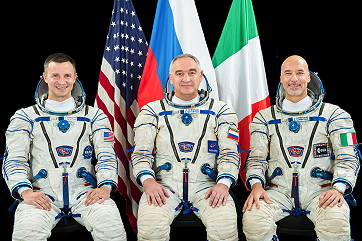 |
 |
 |
Expedition Report
|
ISS Expedition 60 began with the undocking of
spacecraft Soyuz
MS-11 on June 24, 2019 at 23:25:33
UTC. The former Expedition 59 (Oleg
Kononenko, David
Saint-Jacques and Anne
McClain) returned safely to Earth. On July 03, 2019, an ISS reboost was performed using Zvezda thrusters. This reboost was to set up for the launch of manned Soyuz MS-13 and the launch of unmanned freighter Progress MS-12. The engines started at 00:18 UTC and fired 34 seconds. The ISS got 0.52 m/sec. more speed. The actual parameters are 411.4 km x 436.4 km. The ISS needs 92.78 minutes for each orbit. Following an only six-hours solo flight Soyuz MS-13 docked to ISS on July 20, 2019. Aleksandr Skvortsov, Luca Parmitano and Andrew Morgan became the ISS Expedition 60 (together with ISS Expedition 59 crew members Aleksei Ovchinin, Nicklaus Hague and Christina Koch). With the arrival Expedition 60 became a six-person-crew. NASA commercial cargo provider SpaceX launched its 18th commercial resupply services mission to the International Space Station at 22:01:56.492 UTC on July 25, 2019. Loaded with 5,097 pounds (2,312 kilograms) supplies and critical materials to directly support dozens of the more than 250 science and research investigations that will occur during Expeditions 60 and beyond, the SpaceX Dragon spacecraft (CRS-18 or SpX-18) launched on a Falcon 9 rocket from Space Launch Complex 40 at Cape Canaveral Air Force Station (CCAFS) in Florida. Onboard the freighter was the EVA spacesuit EMU No. 3009 which replaced EMU No. 3003. No. 3003 was returned to Earth with Dragon. In addition to bringing research to station, the Dragon's unpressurized trunk is carrying the International Docking Adapter-3 (IDA-3), which, when installed on the space station, will provide the microgravity laboratory with two common ports enabling expanded opportunities for visiting vehicles, including new spacecraft designed to carry humans for NASA's Commercial Crew Program. Dragon reached its preliminary orbit about 10 minutes after launch. It then deployed its solar arrays and began a carefully choreographed series of thruster firings to reach the orbiting laboratory two days later on July 27, 2019. When it arrived, Nicklaus Hague and Christina Koch (acting as a backup) grappled Dragon (13:11 UTC). Andrew Morgan assisted the duo by monitoring telemetry during Dragon's approach. After Dragon's capture, ground controllers sent commands from mission control in Houston for the station's arm to rotate and install the spacecraft on the bottom of the station's Harmony module (16:01 UTC). The Dragon spacecraft spent about five weeks attached to the space station. Dragon remained at the orbital outpost until August 27, 2019, when the spacecraft returned to Earth with research and return cargo. Filled with trash, the unpiloted Russian cargo ship Progress MS-11 undocked from the Pirs module of the International Space Station at 10:44 UTC on July 29, 2019. Later Russian flight controllers sent commands to fire the Progress' engines and deorbit the space freighter, sending it to a destructive entry over the unpopulated South Pacific Ocean. The launch of the unpiloted Russian Progress MS-12 occurred on July 31, 2019 at 12:10:46.153 UTC from the Baikonur Cosmodrome in Kazakhstan. The freighter delivered almost three tons of food, fuel and supplies to the International Space Station components for the life support system, as well as containers with food, clothing, medical supplies and personal hygiene items for the crewmembers are stowed in the cargo compartment. The Progress MS-12 spacecraft docked to the Pirs docking compartment at the Russian segment at 15:29 UTC, July 31, 2019. Progress MS-12 remained docked at the station for more than four months before departing November 29, 2019 for its deorbit into Earth's atmosphere. More than three months after delivering several tons of supplies and scientific experiments to the International Space Station, Northrop Grumman's Cygnus cargo spacecraft, the "SS Roger Chaffee", departed the orbiting laboratory on August 06, 2019 at 16:15 UTC. Expedition 60 Flight Engineers Nicklaus Hague and Christina Koch used the station's Canadarm2 robotic arm to release Cygnus after ground controllers remotely unbolted the craft from the Earth-facing port of the Unity module and maneuver it into release position. Within 24 hours of its release, Cygnus began its secondary mission, deploying a series of CubeSats. Once at a safe distance away from station, two deployment systems - one provided by NanoRacks and the other by Hypergiant SEOPS (Satellite, Extraterrestrial Operations and Procedures) - began deploying the small satellites. After about a month of free-flight operations, NASA's Seeker Robotic External CubeSat Inspection Vehicle was deployed and operations began to demonstrate its ability to maneuver around Cygnus and take high-resolution photos. Seeker will transmit those images to its Kenobi receiver inside Cygnus for storage and transmission to the ground at a later date. Cygnus also demonstrated a Control Moment Gyroscope attitude control system and performed operations for the UbiquitiLink payload during the secondary mission. Cygnus remained in orbit until later in 2019 to demonstrate Northrop Grumman's ability to fly two Cygnus spacecraft simultaneously and support payloads on the cargo craft for extended durations. On August 15, 2019, an ISS reboost was performed using Progress MS-12 thrusters. This reboost was to set up for the launch of unmanned Soyuz MS-14. The engines started at 05:43 UTC and fired 585 seconds. The ISS got 0.58 m/sec. more speed. A second ISS reboost was performed using Progress MS-12 thrusters. The engines started at 08:45 UTC and fired 585 seconds. The ISS got 0.58 m/sec. more speed. The actual parameters are 415.0 km x 428.7 km. The ISS needs 92.82 minutes for each orbit. On August 21, 2019 Nicklaus Hague and Andrew Morgan performed the first spacewalk in this expedition (6h 32m). The duo assisted in the installation of International Docking Adapter-3 (IDA-3) to Pressurized Mating Adapter-3 on the space-facing side of the station's Harmony module. IDA-3 will provide a second docking port to the International Space Station to accommodate the future arrivals of Boeing CST-100 Starliner and SpaceX Crew Dragon commercial crew spacecraft. The docking port was launched to the station in July 2019 on the SpaceX Dragon SpX-18 or CRS-18 on the company's 18th commercial cargo resupply services mission to the station. IDA-2 was installed to the forward end of the Harmony module in the summer of 2016. NASA's commercial crew partnership with Boeing and SpaceX will restore launches of American astronauts from American soil on American rockets and maximize the time U.S. crews can dedicate to scientific research and technological advances aboard the orbiting laboratory to enable the agency's ambitious goals for the Artemis lunar exploration program and future missions to the Moon and Mars. The unmanned spacecraft Soyuz MS-14 launched from the Baikonur Cosmodrome on August 22, 2019 at 03:38:31.987 UTC. The approach of the uncrewed Soyuz MS-14 to the International Space Station was aborted at 05:36 UTC on August 24, 2019, after the spacecraft encountered an unspecified problem with its KURS automated rendezvous system at a distance of about 200 feet (60 meters) from the orbital laboratory. Aleksandr Skvortsov, joined by Luca Parmitano and Andrew Morgan, relocated the Soyuz MS-13 spacecraft to a new docking port on the International Space Station on August 26, 2019, clearing a spot for the unpiloted Soyuz MS-14 spaceship to attempt another automated approach to the complex after aborting its first rendezvous. Soyuz MS-13 undocked at 03:35:30 UTC and redocked at 03:59:36 UTC. Engineers working at Russian mission control in Korolyov, near Moscow, determined an amplifier on the space station's Poisk docking module, located on the zenith - or space-facing - side of the Zvezda service module, was not functioning correctly. The amplifier is part of the passive side of the KURS rendezvous radar system, which guides approaching Soyuz crew ships and Progress cargo freighters to automated dockings with the space station. The active side of the KURS radar system, located on the Soyuz itself, is designed to send signals toward the station to determine the range and closure rate between the two vehicles. The data feeds into the Soyuz flight computer to govern its final approach, firing thrusters to control the ship's speed and orientation relative to the station. The test spacecraft finally docked to the International Space Station on August 27, 2019 at 03:08:42 UTC. Filled with almost 3,400 pounds (1,542 kg) of valuable scientific experiments and other cargo, SpaceX Dragon SpX-18 or CRS-18 resupply spacecraft left the International Space Station on August 27, 2019 at 14:59 UTC. Robotic flight controllers at mission control in Houston issued remote commands to release Dragon from the Earth-facing port of the Harmony module using the station's Canadarm2 robotic arm. Expedition 60 Flight Engineer Christina Koch backed up the ground controllers and monitor Dragon's systems as it departed the orbital laboratory. Dragon fired its thrusters to move a safe distance from the station, and then execute a deorbit burn as it heads for a parachute-assisted splashdown in the Pacific Ocean, some 300 miles (480 km) southwest of Long Beach, California (20:21 UTC). Dragon SpX-18 or CRS-18 launched on the SpaceX Falcon 9 rocket July 25, 2019 from Space Launch Complex 40 at Cape Canaveral Air Force Station in Florida, and arrived at the space station two days later. Soyuz MS-14 undocked on September 06, 2019 at 18:14:53 UTC and landed at 21:33:23 UTC 147 km southeast of Dzheskasgan. On September 14, 2019, an ISS reboost was performed using Zvezda thrusters. This reboost was to set up for the undocking and landing of manned spacecraft Soyuz MS-12 on October 03, 2019. The engines started at 18:41 UTC and fired 39.5 seconds. The ISS got 0.6 m/sec. more speed. The actual parameters are 412.1 km x 437.9 km. The ISS needs 92.8 minutes for each orbit. The unmanned Japanese freighter H-II Transfer Vehicle KOUNOTORI8 or HTV-8 was launched on September 24, 2019 at 16:05:05 UTC atop a H-IIB carrier rocket flying from pad 2 of the Yoshinobu Launch Complex at Tanegashima. The Japanese cargo spacecraft was loaded with 8,326 pounds (3,777 kilograms) of supplies, spare parts and experiment hardware. Around 5,313 pounds (2,410 kilograms) of cargo was loaded inside the HTV's pressurized logistics carrier, including a Sony-developed laser communications experiment, hardware for a cellular biology research rack and fresh water. Named Kounotori, meaning white stork in Japanese, the craft delivered six new lithium-ion batteries and corresponding adapter plates that will replace aging nickel-hydrogen batteries for two power channels on the station's far port truss segment. The batteries were installed through a series of robotics and spacewalks by the station's crew members in 2019 and January 2020. Additional experiments on board HTV-8 included an upgrade to the Cell Biology Experiment Facility (CBEF-L), a small-sized satellite optical communication system (SOLISS), and a payload for testing the effects of gravity on powder and granular material (Hourglass). On September 25, 2019 at 13:57:42.701 UTC the Russian spacecraft Soyuz MS-15 launched from the Baikonur Cosmodrome. The crew consists of Oleg Skripochka, Jessica Meir and Hazzaa Al Mansoori. Only six hours later Soyuz MS-15 docked to the International Space Station at 19:42:40 UTC. Oleg Skripochka and Jessica Meir will become members of the new Expedition 61 in the moment of Soyuz MS-12 undocking on October 03, 2019 at 07:36 UTC (together with Expedition 60 crew members Luca Parmitano, Aleksandr Skvortsov, Andrew Morgan and Christina Koch. Spaceflight Participant Hazzaa Al Mansoori from the United Arab Emirates is scheduled to land with Aleksei Ovchinin and Nicklaus Hague onboard Soyuz MS-12 on October 03, 2019. The spacecraft HTV-8 arrived at the station on September 28, 2019. Expedition 60 Flight Engineer Christina Koch, backed up by her crewmate Andrew Morgan, operated the station's Canadarm2 robotic arm from the station's cupola to capture the 12-ton spacecraft as it approaches from below (11:12 UTC). Robotics flight controllers then took over the operation of the arm to install HTV-8 to the Earth-facing port of the Harmony module (14:09 UTC) where it spent a month attached. Flight Engineer Luca Parmitano monitored HTV-8 systems during its approach to the station. Finally, the station command changed from Russian cosmonaut Aleksei Ovchinin to Italian astronaut Luca Parmitano. ISS Expedition 60 concluded with the undocking of Russian spacecraft Soyuz MS-12 on October 03, 2019 at 07:37:32 UTC. The landing crew consisted of Aleksei Ovchinin, Nicklaus Hague and Spaceflight Participant Hazzaa Al Mansoori from the United Arab Emirates. Three-and-a-half-hours later the crew landed safely in Kazakhstan. So, the new Expedition 61 consisted of ISS-Commander Luca Parmitano, Andrew Morgan and Aleksandr Skvortsov (all three arrived with Soyuz MS-13), Christina Koch (since the docking of Soyuz MS-12 onboard) plus Oleg Skripochka and Jessica Meir (both had reached the station onboard Soyuz MS-15 together with Spaceflight Participant Hazzaa Al Mansoori). Among the US experiments are: BioFabrication Facility (BFF): Using 3D biological printers to produce usable human organs has long been a dream of scientists and doctors around the globe; however, printing the tiny, complex structures found inside human organs - such as capillary structures - has proven difficult to accomplish in Earth's gravity environment. To overcome this challenge, Techshot designed their BioFabrication Facility (BFF) to print organ-like tissues in microgravity. Microgravity may provide an additional solution to printing complex organ structures, as minimal gravity removes the need for scaffolding structures to support complex tissue shapes. Techshot intends to use the BFF as a platform for researchers to print organ-like tissues in microgravity, acting as a stepping stone in a long-term plan to manufacture whole human organs in space using refined biological 3D printing techniques. Biorock: Microbes are able to weather down a rock from which they can extract ions. This natural process enables biomining, in which useful metals are extracted from rock ores. Already a common practice on Earth, biomining may eventually take place on the Moon, Mars and asteroids as we expand our understanding and exploration of the solar system. Biorock is expected to help gain additional insight into the physical interactions of liquids, rocks, and microorganisms under microgravity conditions for novel acquisition of materials in space. In addition, data from Biorock can be used to inform the development of life support systems involving microbial components on long-duration spaceflight missions. Goodyear Tire: Pushing the Limits of Silica Fillers for Tire Applications (Goodyear Tire) evaluates creation of novel silica forms and structures, or morphologies, using traditional techniques to form silica fillers in microgravity. The space environment may yield results not possible in ground-based environments. Better understanding of silica morphology and the relationship between silica structure and properties may improve the silica design process and rubber formulation, as well as tire manufacturing and performance on the ground. Recent experiments in microgravity have generated novel mixtures of solids and liquids with the potential to improve silica morphologies and deliver better performance in the tire industry. A breakthrough in research on the effect of silica morphology on rubber compound properties may lead to significant improvements in fuel efficiency, creating transportation cost savings and helping to protect the environment. Inertial Spreading: Inertial Spreading and Imbibition of a Liquid Drop through a Porous Surface (Inertial Spreading) observes a drop of water spreading over and through a sponge-like metal object. When water touches a sponge-like material such as dry soil, it penetrates microscopic holes too small to see; widening these holes makes the water disappear too quickly. Microgravity slows down this process, allowing use of larger holes for more detailed observations to create a benchmark for computer simulations. This investigation may support development of new technology based on wicking and capillary fluid motion that could ultimately support use of essential resources available on the Moon, Mars or asteroids, known as In-situ Resource Utilization (ISRU). A better understanding of the dynamics of coexisting liquid, gas, and porous solids has potential applications in flood control, irrigation, fuel cells, oil and gas exploration, and pharmaceutical production on Earth. |
EVA data
| Name | Start | End | Duration | Mission | Airlock | Suit | |
| EVA | Hague, Nicklaus | 21.08.2019, 12:27 UTC | 21.08.2019, 18:59 UTC | 6h 32m | ISS-60 | ISS - Quest | EMU No. 3006 |
| EVA | Morgan, Andrew | 21.08.2019, 12:27 UTC | 21.08.2019, 18:59 UTC | 6h 32m | ISS-60 | ISS - Quest | EMU No. 3008 |
Relocations of Manned Spacecrafts
| Spacecraft | from | Undocking | Time UTC | to | Redocking | Time UTC |
| Soyuz MS-13 | ISS - Zvezda | 26.08.2019 | 03:35:26 | ISS - Poisk | 26.08.2019 | 03:59:32 |
Photos / Graphics
 |
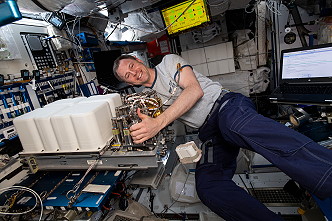 |
 |
 |
 |
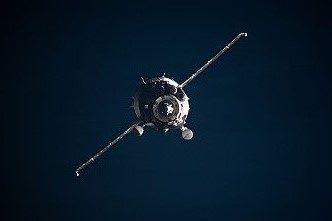 |
 |
 |
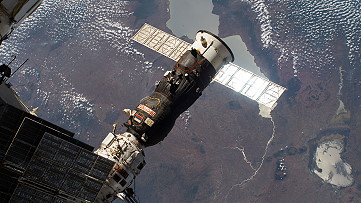 |
 |
 |
 |
 |
 |
 |
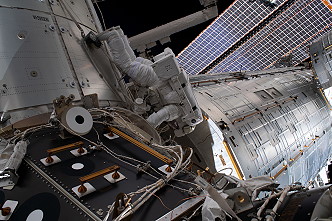 |
 |
 |
 |
 |
 |
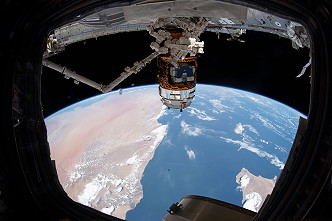 |
 |
|
more onboard photos |
|
more EVA photos |
|
more Earth observation photos |
|
| © |  |
Last update on December 08, 2023.  |
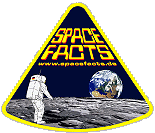 |